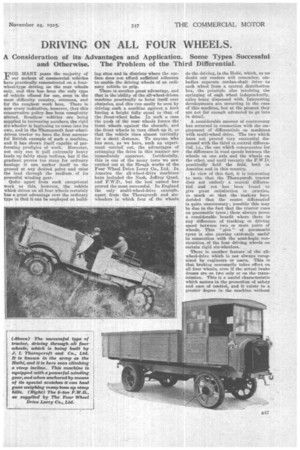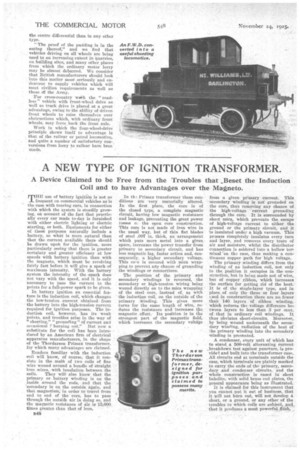DRIVING ON ALL FOUR WHEELS.
Page 31

Page 32

If you've noticed an error in this article please click here to report it so we can fix it.
A. Consideration of its Advantages and Application. Some Types Successful and Otherwise. The Problem of the Third Differential.
FOR MANY years the majority of our makers of commercial vehicles have praCtieally concentrated on a fourwheel-type driving on the rear wheels only and this has. been the only type of vehicle offered for use, even in the most difficulty country, overseas, and for the roughest work here. There is now every indication, however, that this conservative policy has been completely altered. Readiest; vehicles are being supplied in increasing numbers, the rigid six-wheeler is beginning to come into its OWP, and in the Thornyereft four-wheeldriven tractor we have the first successful _British example of such a machine, and it has shown itself capable of performing prodigies of work. Moreover, not only can it pull extremely heavy loads up fairly steep inclines, but if the gradient proves too steep for ordinary haulage it can anchor itself to the ground at any desired point and raise the load through the medium of its powerful winding gear.
Quite apart from such exceptional work as this, however, the vehicle which drives on all four wheels certainly has a great advantage over the ordinary type in that it can ha employed on build lug sites and in districts r where the sm.face. does not afford sufficient adhesion to enable the driving wheels of an ordinary vehicle to grip.
There is. anothergreat advantage, and that is the ability of the all-wheel-driven machinepractically to hoist itself over obstacles, and this can easily be seen by driving such a machine against a kerb having a height fully equal to that of the front-wheel hubs. .In such a ease the push of: the rear wheels forces the front wheels against the obstacle, and the front wheels in turn climb up it, so that the vehicle rises almost vertically for a short distance. To anyone who has seen, as we have, such an experiment carried out, the• advantages of arranging the drive in this manner are immediately apparent. Incidentally, this is one of the many tests we saw carried out at the Slough works of the Four Wheel Drive Lorry Co., Ltd, In America the all-wheel-drive machines have included the Nash, Jeffrey Quad,. and F.W.D., but the last named has proved the most Successful. In England the only multi-wheel-drive example. apart from the Thornycroft and sixwheelers in which four of the wheels do the driving,ris the HolIe, which, as no doubt our readers will remember, embodies separate cardareshatt drive to each wheel from a central distribution box, the principle also involving the springing of each wheel independently, axles being dispensed with. Interesting developments are occurring in the case of this machine, but at the present they are not far enough advanced to go intoin detail.
A considerable amount of controversy has occurred in connection with the employment of differentials on machinea with multi-wheel drive. The two which have not proved very successful dispensed with the third or central differential, i.e., the one which compensates for the difference in road speeds between the wheels on one axle and the wheels on the other, and until recently the F.W.D. practically held the field, both in America and in this country.
In view of this fact, it is interesting ta note that the Thornycroft tractor does not embody a central differem tial and yet has been found to give great satisfaction in practice, so much so that the 'makers havt decided that the centre differential is quite unnecessary ; possibly this may be due to the fact that the tractor runs on pneumatic tyres ; these always prove a considerable benefit where there is any difference of tracking or driving speed between two OT more pairs of wheels. This " give " of pneumatic tyres is also proving extremely useful in connection with the semi-bogie construction of the four driving wheels on certain rigid six-wheelers.
There is another feature of the allwheel-drive which is not always recognized by engineers or users. This is that braking necessarily takes effect on all four wheels, even if the actual brake drums are on two only or on the transmission. This is a useful characteristic which assists in the promotion of safety and ease of control,. and it exists to a greater degree in the machine without the centre differential than in any other type.
The proof of the pudding is in the eating thereof," and we find that . vehicles driving on all wheels are being used to an increasing extent in quarries, on building sites, and many other places from which the ordinary motor lorry may be almost debarred. We consider that British manufacturers should look into this matter most seriously and endeavour to supply vehicles which will meet civilian requirements as well as those df the Army.
For cross-country wk the " roadless " vehicle with front-wheel drive as well as track drive is placed at a great advantage, owing to the ability of driven front wheels to raise themselves over obstructions which, with ordinary front wheels, may force back the front axle.
Work in which the four-wheel-drive principle shows itself to advantage is that of the railcar or petrol locomotive, and quite a number of satisfactory conversions from lorry to railcar have been made.




































